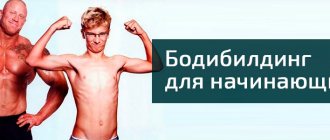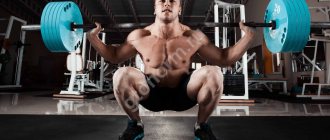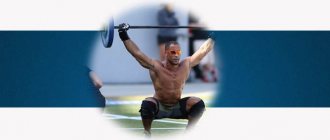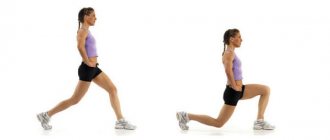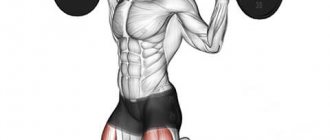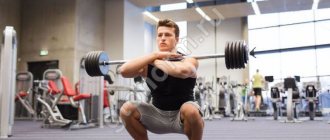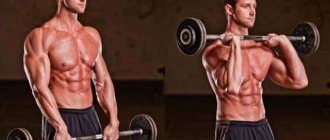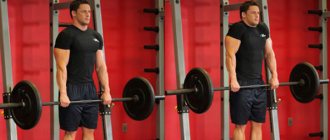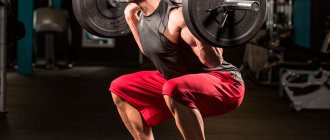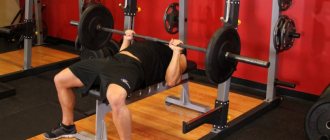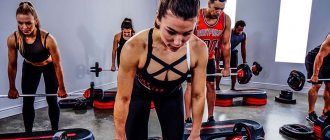In most sports disciplines, functional development of the legs is the key to an athlete’s effectiveness. The best exercise for training the lower extremities is squats. The element involves several joints and large muscles: quadriceps and gluteus maximus. Thanks to this, the athlete increases speed and strength.
Squats improve body balance by developing stabilizing muscles:
- leading;
- calf;
- soleus;
- hamstrings;
- abdominal;
- back extensors.
https://youtu.be/tUB4yILsPs0
The Positive Effects of Squats
The main advantage of the exercise is its complex effect. An athlete who uses squats in training develops not only muscles, but also improves body function:
- Strengthening the heart . High-speed multi-repetition squats without additional weights are equivalent in effectiveness to full-fledged cardio exercises - the main training of the heart muscle and increasing endurance.
- Mass gain . We are talking about exercises with power equipment. Squats with a barbell on the shoulders provide a powerful boost to the production of growth hormones, which makes the element basic in the training program of bodybuilders and powerlifters.
- Strengthening the male reproductive system . Athletes who regularly squat with a barbell or other weights improve blood circulation in the pelvic organs, which helps to improve the genitourinary system and restore libido.
- Lower body workout for women . Most gym goers dream of having toned thighs and round buttocks. Squats help to specifically load these muscle groups and get rid of flabbiness.
- Losing weight . The reduction of subcutaneous fat depends on the energy intensity of the exercise. Squats force large muscles to consume a large number of calories, which means getting rid of extra pounds and cellulite.
The exercise is used to recover from sprains and injuries. Light squats of half the amplitude without additional weight will help strengthen joint tissues and tendons and return mobility to the athlete.
Classical technique
There is a basic squat technique that is common to most similar exercises. It should be carefully disassembled before starting classes:
- We place our feet shoulder-width apart, parallel to each other.
- Body weight is distributed over the entire surface of the feet.
- We lower our arms freely to our sides.
- We keep our head straight and constantly look forward.
- We tighten our stomach, inhale, and smoothly lower our pelvis.
- At the same time, we bring our arms out in front of us to the horizontal.
- We don’t linger at the bottom point—exhale and return to the vertical position.
Having learned how to squat correctly using the classical technique, try to shift the emphasis of the load. This will help to qualitatively work out individual muscle groups.
For example, an exercise with a wide stance allows you to fully load the buttocks and stretch the inner thighs. This variation is often used by girls to work out problem areas.
Another example is squats with narrow leg stance. They have an accentuated effect on the quadriceps. The exercise is usually performed with additional weights and is used by men to increase the strength and volume of the lower extremities. Girls are recommended to do narrow squats in the Smith machine. This will dry out your thighs and make your legs slimmer.
Now about the depth of the squat. For beginner athletes with weak thigh muscles, we recommend lowering the pelvis to a right angle at the knee joints. This technique specifically strengthens the femoral part of the legs. Experienced athletes (without medical contraindications) can lower themselves into a squat “all the way.” This will allow you to better stretch your gluteal muscles and also increase your strength.
https://youtu.be/C_VtOYc6j5c
Technique for performing hack squats with a barbell
- The athlete must place his feet shoulder width apart. The spine should be straightened. Round your chest, straighten your shoulders.
- The barbell should be placed behind you in your hands. The grip is straight (palms facing back).
- The movement starts from the bottom position. To do this, you need to bend your knees so that they do not extend forward beyond your feet. The torso should be vertical, the spine should be straight.
- The upward movement occurs due to the work of the legs and is performed smoothly, without jerking. Lifting the weight is done while exhaling.
- There is no pause in the upper part of the amplitude. The downward movement is smooth and slow. During the downward movement, the hips should be pushed back, as if performing a deadlift. The barbell is lowered while inhaling.
- Please note that when performing these or any other squats, you cannot bring your knees forward beyond your feet. This may cause knee injury.
- Do not under any circumstances round your back while performing the exercise. This violation of technique also causes serious injuries.
- The weight should be at the level of the heels.
- Also, under no circumstances should you bring your knees together. They should “look” in the same direction as their feet.
Squat mistakes
Let's look at common shortcomings in the technique that interfere with the development of the athlete and reduce the effectiveness of the exercise:
- Bringing the hips inward as you lower. Make sure your knees remain in line with your feet. Otherwise, the dangerous load on the knee joints increases.
- Incorrect breathing. You should exhale with effort, that is, when rising from the lowest point. Errors in this nuance affect the effectiveness of the squat.
- "Throwing" the body down. Typically for beginner athletes who have undeveloped leg muscles. Raising and lowering must be uniform and controlled.
- "Rounding" of the back. A dangerous mistake, especially when performing squats with additional weights. The spine should be kept straight and the lower back arched.
- Strong forward lean. During a squat, a natural tilt of the body appears. You should not “pillow” your chest down, as this will lead to loss of balance.
Ignoring mistakes can cause pain in the knee joints, lower back and spine. Therefore, you need to work out the basic technique. If you plan to train with heavy weights, we recommend that you learn squats with an instructor who will be able to notice shortcomings in time and correct them.
Pros and cons of barbell hack squats
Pros:
- The exercise focuses on the quadriceps.
- Less load on the spine during movement.
- A large number of muscles are involved in the work.
- This is a basic exercise.
- Considered safer than regular barbell squats.
- You can do it yourself without the help of insurers.
The disadvantage is the complexity of the technique and the inconvenience of holding the barbell, which makes the exercise difficult for beginners.
Twenty-two varieties - who has more?
There are many execution methods, each designed for specific purposes. We offer a brief overview of the most popular types of squats. You will find detailed information on each exercise on our website using the links.
Squats with your own body weight:
- "Aerial". One of the basic elements of CrossFit. Used to develop leg muscles, strengthen ligaments, and improve balance. The technique of “air” squats is almost completely similar to the classical one, but with one important condition - when lowering the pelvis, the hip joints should be slightly lower than the knees.
- Curtsy. The exercise is popular among professional athletes, as it allows you to specifically load the gluteal muscles. Curtsy squats are demanding on body coordination and balance, so beginner athletes may find them difficult. The technique is a reverse lunge with the foot placed behind the line of the supporting leg. Trained athletes use additional weights to increase the load.
- With jumping out. During such squats, the thigh muscles work in an “explosive” mode, which allows you to develop strength characteristics. The athlete puts his hands behind his head and, while inhaling, squats until a right angle is formed in his knees, then jumps vertically from the bottom point with a powerful exhalation. Upon landing, the athlete immediately (without pausing) begins a new repetition.
- Near the wall. The advantage of the exercise is the use of a flat vertical support. This allows you to exclude your back from work and shift the entire emphasis to the buttocks and hips. The element is suitable for girls who want to tighten and strengthen their lower body. In addition, regular use of these squats will help improve your posture. Technique: the athlete presses his back and lower back completely against the wall, performs smooth lifts and lowerings of the body.
- "Pistol." One of the best exercises for developing the lower extremities without weights. The effectiveness is explained by a complex technique - squats are performed on one leg, with the second constantly held in weight. The difficulty lies in maintaining body balance. Therefore, the element is suitable for trained athletes. Beginners, as a rule, use a lightweight version of “pistols”, which involves the use of side support.
- Plie. The name is borrowed from the ballet. The main advantages are a good workout of the buttocks and strengthening of the inner thighs. Therefore, the element is used in women's training programs. The technique requires good mobility of the hip joints. To properly do wide plié squats, you first need to spread your legs as far apart as possible and turn your toes outward. From this position, keeping your back straight, you should smoothly lower and raise your pelvis.
- Sumo. The exercise effectively loads the leg muscles. The technique as a whole is very close to plie, but has a number of significant differences. Firstly, in sumo the legs are wider than shoulder-width apart, but not to the maximum. Secondly, when performing sumo squats, the feet should not be turned too far to the sides, as in plie, but at an angle of 40–45°. This allows you to maintain body balance when using heavy implements. Thirdly, in sumo the athlete moves the pelvis back and slightly tilts the body forward, while in plie the body is held vertically.
- Sissy. Target muscles are quadriceps. The exercise has an unusual technique, so it may seem strange to many. The athlete stands up straight and places his feet at shoulder level. Then with one hand he grabs any support and rises on his toes. From this position, while inhaling, he simultaneously bends his knees and moves his back back. The angle between the thigh and shin in the lower position must be at least 90°.
- "Scissors". The exercise comprehensively develops the muscles of the lower extremities: calves, quadriceps, buttocks. The technique is a lunge squat. The athlete stands up straight and puts one leg forward. The load will depend on the width of the step. Then, holding the body vertically, the pelvis is lowered until the knee of the “back” leg touches the floor.
Squats with additional weights:
- With a barbell on your shoulders. A classic basic exercise performed in disciplines such as powerlifting, bodybuilding, and weightlifting. Used to increase strength and volume of leg muscles. Squats with a barbell stimulate the hormonal system and contribute to the growth of the athlete’s overall muscle mass, and strengthen joints, ligaments, and tendons. For a detailed description of the technique and all the nuances of implementation, see the link.
- Smith machine squats. The trainer has a fixed bar that slides along guides. This design allows girls and beginner athletes to perform power squats. The benefits also include safety for the spine and lower back. The Smith machine is used for different squats: narrow, wide, scissors and others.
- On my knees. A specific strength exercise used to strengthen the hips and buttocks. It puts a lot of stress on the lower back, so it is not recommended for beginner athletes. Typically performed with light weight on the shoulders. When using heavy equipment, it is best to do similar squats in a Smith machine.
- Half squats. An exercise classified as auxiliary. Used to strengthen quadriceps. Due to the incomplete amplitude of the squat, the muscles of the buttocks and lower legs are practically not used and act as stabilizers. A special feature of the technique is squatting to an angle of 110–120° at the knee joints. All other nuances - straight back, arch in the lower back, raised chin - are preserved.
- Overhead (with a barbell above your head). A complex element that strengthens not only the muscles of the lower extremities, but also the back, shoulders, and arms. The athlete takes the barbell with a wide grip and lifts it above his head. From this position, classic squats are performed. Exercise also promotes the qualitative development of small stabilizer muscles, which has a positive effect on body balance.
- Frontal. Designed for accentuated load of quadriceps. The athlete places the barbell not on the trapezius, but on the upper chest and front deltoids. Squats are performed from this position. By shifting the center of gravity of the projectile forward, the axial impact on the spine is reduced. This means that athletes with back problems can put quality stress on their legs without fear of aggravating their condition.
- Jefferson Squats. Exercise to develop the quadriceps femoris muscle. The advantages include the absence of compression load on the vertebrae, additional strengthening of the arms and deltas. The technique is specific - the barbell is located between the athlete’s legs. Thanks to this, small muscles that are poorly used during regular squats receive a good load.
- Zercher squats. Used to develop large leg muscles. The peculiarity of the technique is that the athlete holds the barbell on the elbows, at the level of the abdomen. Thanks to this design, the back muscles act as a stabilizer, which allows you to strengthen the body as a whole.
- Hatfield squats. This element uses a special neck with a soft cushion and stops. The projectile can be safely placed on the shoulders and not even supported by hands. Experienced bodybuilders recommend performing similar squats at the end of training to “clog” the leg muscles.
- Hackenschmidt squats. The exercise allows you to perform strength approaches without the use of insurance or a partner. The athlete holds the barbell in his hands behind him and performs squats until the plates touch the floor. The benefits of the exercise include safety for the back and good exercise for the legs. In modern fitness centers you can find specialized machines that simulate hack squats.
- With dumbbells. These apparatuses are used in various squats: with different leg widths, scissors, sumo, plie, curtsy and others.
- With sandbag (training bag). The apparatus is filled with sand and has comfortable straps for grip, which allows you to use it in different exercises. For example, squats with a sandbag held on the chest or behind the back are very popular. Such exercises develop the muscles of the body and prepare the athlete for heavy loads.
- Goblet (with weight). Squats with this apparatus are similar to elements with dumbbells, but have several advantages: comfortable holding the weight with both hands and small size. The range of applications is wide - kettlebells can be added to almost all types of squats without weight to create additional load.
Comparison of squats with other exercises
In fitness, one of the most popular exercises for the lower body is lunges. Using various options for performing the element, you can specifically load individual muscles: quadriceps, calves, buttocks. Lunges without additional weights, performed at a fast pace, are suitable for fat-burning workouts.
The main disadvantage of the exercise is the inability to build large muscle volumes due to the use of relatively small weights. During a lunge, the athlete needs to have good control of his body balance, which is not easy with a heavy implement on his shoulders. Therefore, classic barbell squats are much more effective for building muscle mass and increasing leg strength.
https://youtu.be/jyphzYKrptw
Another exercise for training the lower extremities is leg presses. The element is performed in a special simulator and involves pushing a carriage with a load upward at an angle of 45°.
Presses are a strength, basic exercise, so they can be used as a replacement for classic squats. The main advantage is the elimination of the back from the work. Thanks to this, even athletes with spinal injuries can safely train for strength and mass.
The bench press machine allows you to shift the emphasis of the load to different parts of the legs. This is achieved by changing the placement of the feet on the platform. But the main advantage of the exercise is the ability to exercise with much more weight than with classic squats with a barbell.
Records according to various powerlifting federations
According to the international federation WPC, the record in the over 140 kg category was set by Andy Bolton, who lifted a barbell of 520 kg. To be fair, it should be noted that in 2007 the athlete was able to squat with 550.5 kg on his back. But since he was outside the federations at that moment, the record cannot be included in any category.
According to the IPF version, it is impossible to find the same serious results, since the competition requirements of its organizers are characterized by increased rigor. The IPF record belongs to Hamman Shane, who, with his own weight of 169.4 kg, was able to lift a barbell of 457.5 kg in 1995. Also, for the sake of fairness, it should be noted that the record achieved by Dmitry Ivanov in the Czech Republic (2011) could well be considered a record according to this federation. He lifted a barbell weighing 460 kg, but did not complete the performance in the bench press, so the achievement was not counted.
The IPA Federation holds the absolute world record of all times and weight categories, which we have already discussed. In 2008, Alkhazov installed it, lifting 567 kg.
